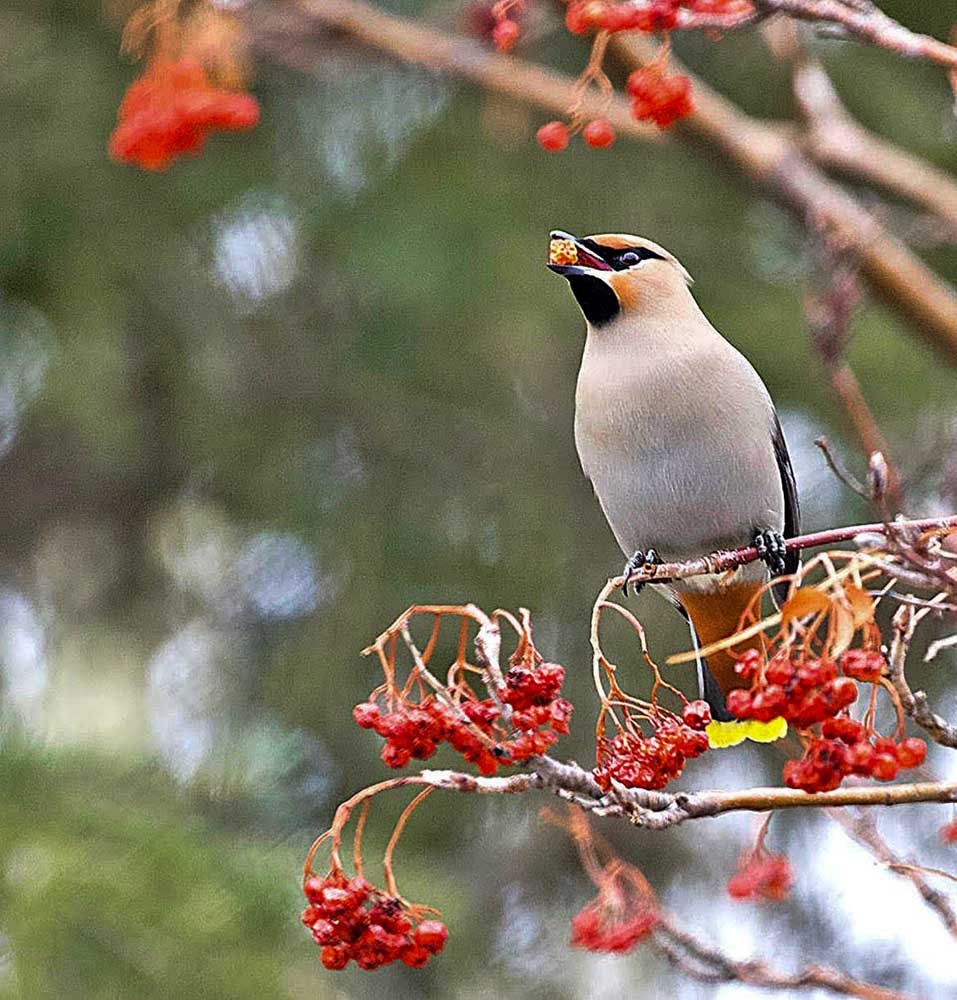Rainy Rambles: Get to know the cedar waxwing
Published 9:00 am Monday, December 16, 2024

- A bohemian waxwing captures a mountain ash berry.
Cedar waxwings are delightfully social birds, and having a flock of them descend on a bush of berries in winter is a treat to watch.
These migratory birds are found in North and Central America, from Canada to Costa Rica, coast to coast. The northern portion of the United States may see them year-round.
They prefer wooded or semi-open areas with plenty of trees and shrubs. These offer plenty of shelter, as well as the fruits that are the mainstay of their diet.
While they are abundant in the wild, they will also reside in suburban and urban areas that have sufficient green space. This adaptability means their numbers have remained relatively stable, compared to other species whose populations have been shrinking in recent decades.
With a total length generally between 5.5 to 7 inches, they are of medium build, neither particularly slender nor stocky, with typical songbird proportions and a slender beak. The tail is of medium length and makes up about one-quarter of the bird’s length. The head features a crest of feathers that may be raised with excitement. The tip of the tail is squared off, and in flight, the wings are somewhat triangular with a pointed tip.
These striking birds are a beautiful light brown on the head and breast that almost appears to have a slight pink tint in the right light; the upper part of the body is gray, though the boundary between gray and brown on each bird may vary. The wings and tail are gray, sometimes with brown “shoulders” on the upper part of the wings when folded. The belly is decidedly yellow, while the underside of the tail is white.
Adult cedar waxwings have a black mask stripe over the eyes that wraps up toward the crest and has fine white lines above and below it. The throat just below the beak is also dark.
A good look at the tips of the secondary wing feathers reveals the red spots that look like drips of candle wax, giving the bird its name; some birds may lack these spots. The tail feathers are also tipped, but in bright yellow, though they may be orange if the bird has excessively eaten the berries of invasive honeysuckle species.
Juvenile cedar waxwings are less brilliantly colored, tending toward a brownish-gray body and head with a white belly, and the facial mask is less extensive. They won’t get their crest or red wingtips until adulthood.
Even during breeding season, these social birds will nest close to their waxwing neighbors. Their courtship rituals are also adorable, involving hopping back and forth, passing a little gift of food between each other. They raise one to two nests of young a year, each clutch consisting of anywhere from two to six babies that have hatched out of light blue or gray eggs, sometimes with darker gray spots.
These birds are primarily frugivorous, subsisting on berries and other fruit throughout the year. However, during the warmer months, they’ll also supplement their diet with insects and other small arthropods.
They require wooded and shrubby areas to find food and nesting sites and are quite tolerant of human activity. People nearby may hear the waxwings’ high-pitched trilling and whistling calls; flocks of the birds can create quite a racket of twittering sounds.
In spring it is not uncommon to find cedar waxwings intoxicated by fermented berries from the previous year. As with humans, this can cause uncoordinated movement, and they may injure themselves flying into trees, buildings and other solid objects.
Waxwings often fly in large groups with swift, short wingbeats similar to that of common starlings. When foraging they will hop from branch to branch, swallowing berries whole, and picking off convenient insects when present. They are also known to hunt insects over water, skimming and swooping like swallows.
The cedar waxwing may be confused with the Bohemian waxwing, which is alike in appearance. However, it is a little larger and lacks the cedar’s yellow coloration, instead having a gray belly; the brown coloration is limited primarily to the head and neck and cinnamon under the tail. Look at the folded wing of a Bohemian waxwing, and you’ll see a white stripe that is missing from a cedar’s wing.
The tufted titmouse is also a small, gray passerine bird with a crest of feathers on the head, but it is significantly smaller than the waxwings. It has a gray head, back, wings and tail, sometimes with a slight brown tint, and a white belly.
The sides are rust-colored, though these may extend over most or all of the breast and belly. Titmice lack the black mask of the waxwing and have white on their face and throat. They also do not have the red and yellow tips on their flight feathers.




